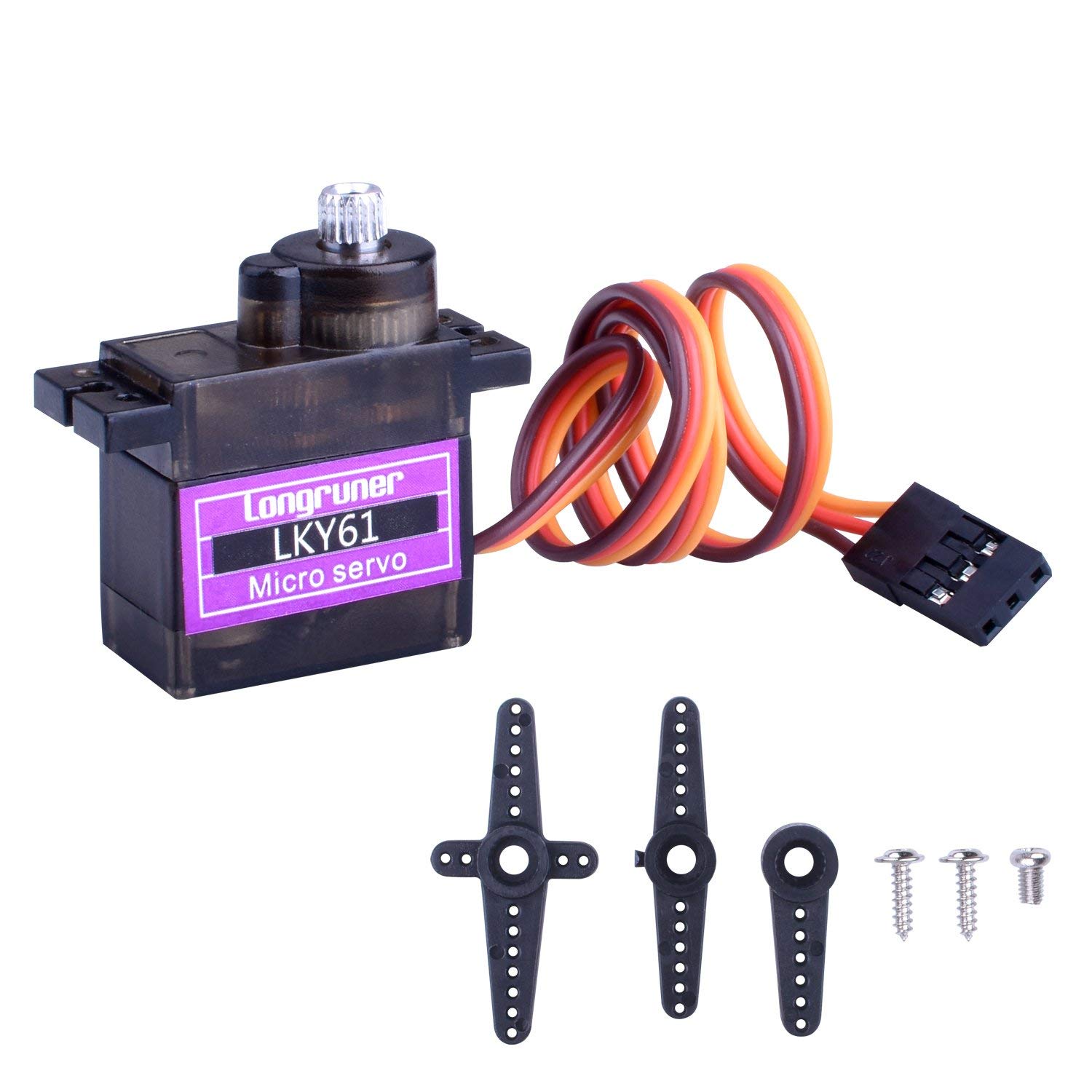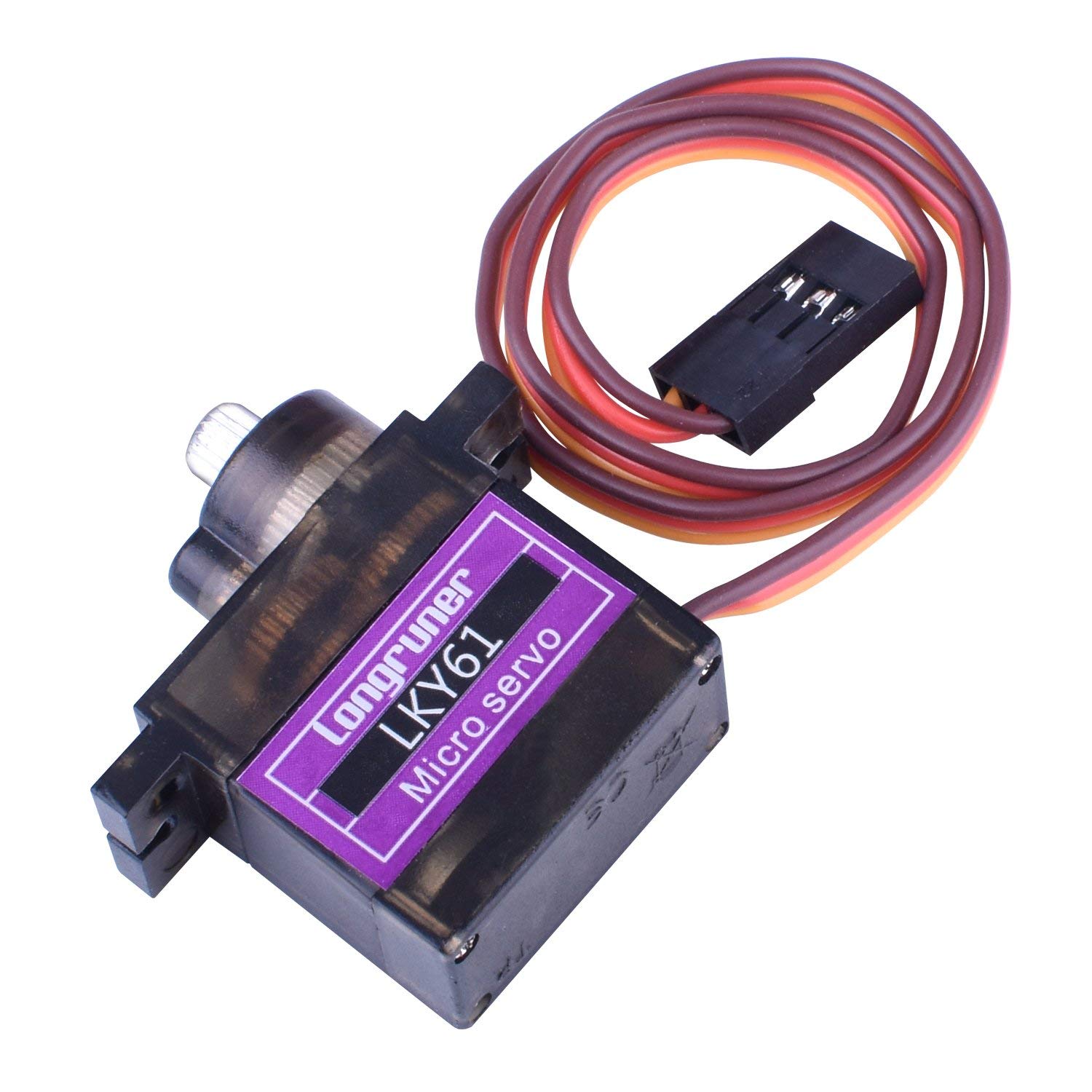







| Package Dimensions | 15 x 10.4 x 4 cm; 9 g |
| Item model number | LKY61-UK |
| Assembly Required | No |
| Batteries Required? | No |
| Batteries included? | No |
| Material Type(s) | cardboard |
| Remote Control Included? | No |
| ASIN | B07236N7Z2 |
N**S
All working
All work fine no issues at all.
D**W
Good value but not perfect
I have some experience of driving these servos from a RPi using an AB Electronics PWM card. The servos were well packaged are arrived quickly. Each comes with 2 mounting screws, 3 control arms and a single screw for mounting the selected arm on the servo.I drove the servo using a pulse rate of 20mS and pulse width of 1mS ->2mS. This resulted in 110deg of movement. I connected one of the arms to a 360deg protractor to make measurements (see picture). I used a 'scope to check the pulse widths being produced by the PWM card for various angles... The top graph shows that setting a particular angle on the RPi results in the correct pulse width. The bottom graph shows that the rotational accuracy is not great. Sorry about the poor curve fitting... I think that it's about 5deg out mid-band which is quite a lot really.Asking for a rotation of much less than 2deg results in no movement at all. Asking for 10 degrees or more results in a fairly repeatable response as per the bottom graph. Between 2 and 10 degrees, you get mixed results.The current demand of each servo is;1.9mA with no pulses at all2.5mA with pulses but no movement75mA with the servo moving, no mechanical loadI did try pulse widths outside the limits above and if you use <0.52mS or >2.5mS it's possible to jam up the mechanism. In this state the servo draws 700mA and gets warm fairly quickly. I thought I'd blown it up but leaving it to cool down restored operation thank goodness. I didn't try this again!Using an iPhone camera in video mode and Windows Media Player in single frame mode, I measured the slew rate (not the most accurate method I admit) and with absolutely no load, I got about 200mS / 60 deg and with the protractor fitted I got 230mS / 60 deg. This is about 1/2 of the quoted speed but it's plenty quick enough for me. These results might be rubbish due to my measurement technique but I think they're right (obviously!). EDIT: After completing this test, I read up on what the angular speed actually means and I've realised that I measured it incorrectly... The speed rating does not include starting/stopping! It assumes that the servo is already rotating as the measurement starts and is still moving after 60 deg of travel. On this basis, the speed of rotation is more like 90mS / 60 deg but this is not very accurate due to my measurement technique. Servo supply was 5VDC while making the measurement.I have not carried out any meaningful load tests but just sticking your finger on the servo arm while it's moving gives quite a lot of confidence that it will work well in service. Although I have most of the testing with a single servo, I've actually had 10 off connected at the same time (to different PWM outputs of course!) and they all worked fine during about 20 hours of non-stop operation.In my application, I'm running totally automated with no user intervention and the lack of small-angle accuracy together with the non-linear angular response might be a problem... I'll find out... I think that for its intended audience (RC model control) it would be fine; the eye->brain->finger feedback loop fixing any of the mentioned problems. At the cost, I think they're really good.
N**S
1 faulty in a pack of 10.
I've purchased a pack of 10 Longruner MG90S and tested all of them using Arduino + Adafruit's motor driver. One of the motors fails to complete the travel; it sometimes stops mid-way, at a different point every time, i.e. exhibits an inconsistent behaviour.
S**X
Five Stars
Brill!
S**F
Mehrere Motoren defekt
Leider kann ich diese Motoren nicht empfehlen. In kürzester Zeit gaben 5 Motoren den Geist auf. Was nützt der günstige Preis, wenn man danach nur Probleme hat. Rückgabe leider nicht möglich, da die Konstruktion auf die Maße des Motors genau abgestimmt sind. Trotzdem zwei Sterne, da zur Zeit 2 Motoren laufen.Nachtrag:Auf Kulanz wurden die Motoren vom Verkäufer ersetzt. Der Verkäufer war sehr daran interessiert, die Ursache für denDefekt der Motoren zu ergründen.Von den neuen Motoren (Typenbezeichnung LKY61) habe ich einen mit einem Arduino Uno getestet. Mit einem einfachen Programm steuerte der Motor die Positionen 0° - 90° - 180° an. Nach ca. 5 Min lief der Motor heiß und bewegte sich nicht mehr von der Position 0°. Ich ließ den Motor abkühlen und passte das Programm so an, dass nun die Positionen 10° - 90° - 170° angesteuert wurden. Mit diesem Programm lief der Motor über 15 Min störungsfrei.Offenbar haben die Motoren Probleme, die maximalen Positionen anzulaufen. Bleibt man darunter, laufen sie störungsfrei.Für Kundenfreundlichkeit und Kulanz erhält der Verkäufer von mir 6 Sterne!!!Die Bewertung für das Produkt hebe ich um 2 Sterne an, da sie funktionieren, aber leider nicht im versprochenen Umfang!
N**1
Funktionieren einwandfrei!
Tolle servos zu einem günstigen Preis!Sie kommen mit allem was man braucht. Die Schraube zur Befestigung der arme sowie die schrauben um den Servo selbst zu befestigen.Die Zahnräder sind aus Metall und halten somit einiges mehr aus als die billigen Plastik Zahnräder bei anderen servos.Alles in allem kann ich sie nur empfehlen!
I**P
Plastikgetriebe bei MG90S!
Auch hier ist es ein Kunststoffgetriebe, obwohl gankz klar ein Metallgetriebe angegeben ist. Auch auf den Bildern klar zu sehen. Wofür Steht das "M" in MG90S?
J**T
su precio
para aviones
B**I
C'est pas les bon modèles
C'est des LKY61 et pas des MG90S. C'est pas les bon modèles.
Trustpilot
1 day ago
1 month ago